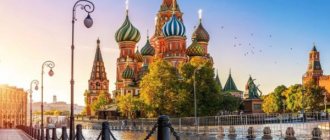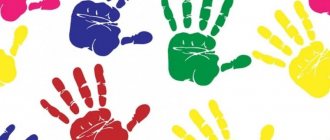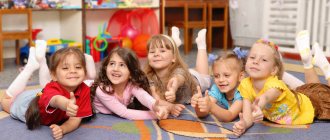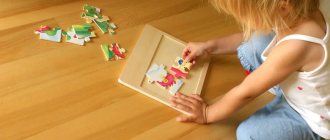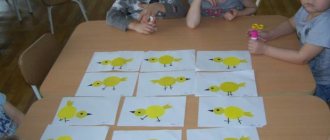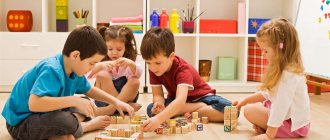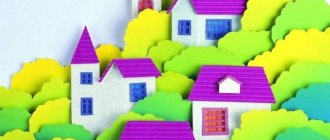Regular swimming lessons have a beneficial effect on the child’s body: they train the musculoskeletal system, strengthen the cardiovascular and respiratory systems, accelerate metabolic processes and improve immunity. Swimming is rightfully considered one of the easiest ways to raise a child healthy, strong and resilient. In addition, activities in water invariably evoke positive emotions in children and improve their mood. The main thing here is to choose a good pool for kids.
Let's try to figure out together where in Moscow to teach a child to swim and how to choose the right pool with a trainer for children.
When choosing a pool for small children under 3 years old, first of all, you should pay attention to indicators such as temperature and method of water purification, as well as the presence or absence of individual lessons in the pool with the child.
In addition to these indicators, we all want to find a children's pool "near me", and this is really important, because in the case of children, the time spent traveling there and back plays a significant role in the effectiveness of the activities. If the child was already tired on the way to the pool, then the training will be of little use. Therefore, when referring to our list of swimming pools for children in Moscow, do not forget to take into account the geographical principle - it will be different for everyone.
Club "Aquademia"
Aquademia is a club for swimming children from 2 months to 6 years old near the Shchukinskaya metro station. Two full-fledged swimming pools allow you to conduct classes in different formats: trainer + baby, trainer + couple (mother and baby) and small groups (up to 4 people). The club staff includes only professional instructors and hydro-rehabilitators with specialized education and necessarily experience working with infants.
Photos of the club "Aquademia"
Water quality is a special pride of Aquademia. The temperature is maintained at 31-33C, the water goes through a triple purification system and is completely renewed in 30-60 minutes.
The gaming Aquademia is worth special attention, so visiting the club should not be limited to time spent in the pool. Children enjoy exploring exciting toys and often stay in the club for more than an hour.
Aquademia is the territory of not only children's, but also parental happiness! Parents can participate in the lesson or watch their baby on the big screen while sitting in a comfortable seating area. The club administrators carefully offer tea, coffee and lemonade.
The founders of the club approached the formation of the concept of the pool with special trepidation and great soul. The design uses not only beautiful, but also environmentally friendly materials.
The club is located at st. Academician Bochvara 3, building 3. The cost of one group lesson is 1000 rubles, individual - from 1500. A subscription for 6 group lessons costs 4560 rubles.
Aqua club “Me and my baby”
Aqua is an excellent option for swimming at a very early age with a specialized pool for babies up to one year old in Moscow.
This pool is not accessible to everyone: only very young swimmers with their mothers and pregnant women practice here.
Children's classes are aimed at two age groups: from birth to 3 years and from 3 to 6 years.
Qualified instructors and teachers of the aquatic center conduct classes using unique proprietary methods. And these are not just swimming lessons in the pool for young children, but lessons using a comprehensive methodology for the physical, psycho-emotional and mental development of children. This means that in addition to swimming lessons, kids learn colors and shapes, poems and songs, and play a lot.
Training for children from 3 to 6 years old includes elements of “big” swimming, active educational games in the water and elements of hardening.
The water temperature in the pool is maintained at 32-33 degrees. The water passes through ultraviolet light and gentle hypochlorination is used. This cleaning system is suitable even for infants.
According to numerous reviews, it can be called one of the best swimming pools for children over one year old in Moscow.
The Aqua Center is located next to the Medvedkovo metro station at the address: st. Malygina, 1, building 2. Also, a branch of the aqua club operates in the Odintsovo district of the Moscow region, in the village of Zhukovka-1.
The cost of a one-time visit to the pool is 1,400 rubles, with a subscription it is more profitable - from 4,700 rubles for 5 lessons of 1.5 hours.
How not to teach your child to swim
Before teaching your child to swim, you should clearly know the methods that should not be used. This will speed up the learning process and avoid sad consequences.
Common mistakes made by parents include:
- extreme methods. For example, an extreme option is to throw a child into water against his will. Parents using this method expect that the child, sensing danger, will magically instantly learn to swim. Such actions can lead to the development of aquaphobia in a child - a panicky fear of bathing, entering water and swimming;
- forcing children to learn to swim. If a child does not want to learn at the moment, you should not force him either through actions or persuasion. Learning to swim will be successful only when the child is psychologically ready for it. When this happens, the child himself will ask you to teach him to float on the water;
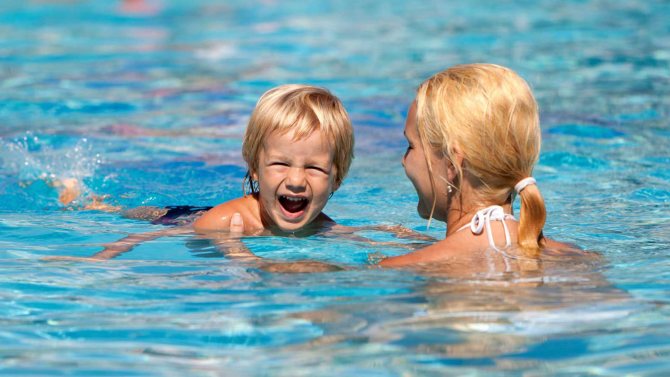
Swimming should bring positive emotions to the child, and not be a forced activity.
- teaching a child to swim if he has contraindications: acute inflammatory diseases;
- high body temperature;
- symptoms of body intoxication: nausea, vomiting, diarrhea;
- bronchial asthma in the acute stage;
- skin infections;
- skin rashes of allergic origin;
- renal or heart failure;
- joint dislocations;
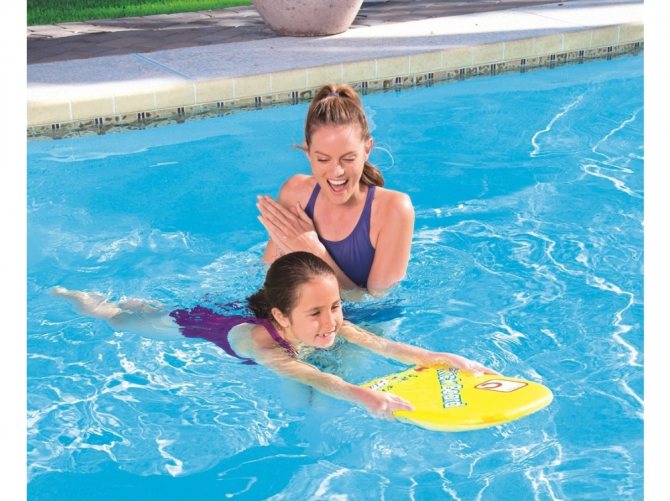
A swimming board is a useful device with which a child will quickly learn to float on the water.
When a person swims “like a dog,” the cervical spine is overloaded, which can lead to the development of scoliosis, osteochondrosis and other orthopedic diseases.
Early swimming studio "Aquaclass"
The early swimming studio "Aquaclass" also conducts children's classes in the pool.
The school is proud of its full compliance with international standards and the use of the latest water treatment technologies. This is definitely a worthy choice of swimming section for children from one year old in Moscow. Before starting to work with children, instructors here undergo strict selection and training using the author’s methodology. During classes, they have to completely replace their parents, who always remain on land.
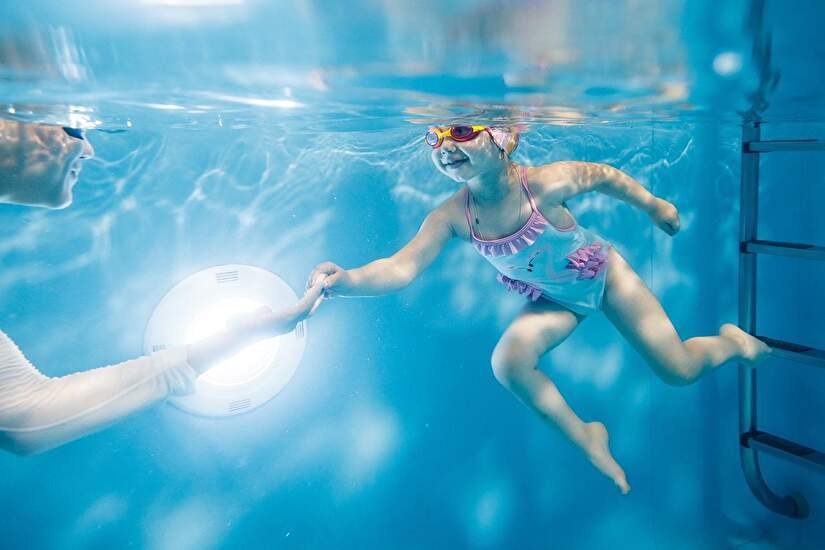
From 0 to 2 years old, the center offers children to try the “Early Start” program, which helps the child get acquainted with water and get used to the new world.
At 2 years of age, the toddler pool opens the “First Mile” course, which helps them feel like a fish in water and get an idea of different swimming styles.
Swimming for children from 4 years old in Aquaclass takes place according to the Champion's Path program, which prepares the child for school stress and helps in the future to become a champion in any sport.
A bright play area organized in the center makes swimming for children from 1 year old even more entertaining and interesting.
The water temperature in the pool is 31-33 degrees. An innovative multi-stage purification system is used with monitoring of water samples every four hours.
The cost of a one-time individual lesson with a trainer is 1950 rubles (first visit - 950 rubles). When purchasing a subscription, the price is reduced.
The Aqua Center is located next to the Telecenter metro station at the address: st. Academician Korolev, 10.
The benefits of swimming for a child
Everyone has heard about the benefits of swimming, but what specific benefits will a child receive from visiting such a section? Among the most obvious are:
- uniform development of all muscles of the body. To hold and move through the water, the child coordinates and uses all the muscles of the body, training and strengthening them. The shoulder girdle, arms, legs, and abs develop best;
- strengthening and relaxation of the musculoskeletal system. In water, the body is lighter than on land, all joints and the spine are relieved of compression load and rest. Swimming is recommended for children with slight deviations in posture and various diseases (consultation with a pediatrician is required first);
- fast growth. Reduced compression load on the joints and spine contributes to the rapid growth of skeletal bones;
- improved coordination. To keep the body on the water and swim, the child needs to coordinate body movements, which has a positive effect on the ability to control his body and feel it;
- the functioning of the pulmonary system improves. In order to swim, boys and girls need to learn to breathe correctly, take deep breaths and short exhalations. Constant training of “correct” breathing improves blood saturation with oxygen and helps improve the pulmonary system;
- strengthening the immune system, hardening the body. Water helps strengthen the body's resistance to temperature changes.
- emotional charge, feeling of satisfaction. If a child attending the swimming section gives his all during training, then at the end of the lesson he feels tired, but satisfied.
- removing negativity, reducing nervous tension, irritability. Exercising in water helps relax the nervous system; through active sports, boys and girls release accumulated negative energy and feel more confident.
You can teach a child to swim starting from 2 weeks of age, but most sections begin accepting those interested after 3 years.
The recommended age for starting a swimming class with a coach is 6-7 years old.
Amateur swimming sections provide classes 2-3 times a week for 1 hour. For children under 6 years old, one lesson in water takes about 20 minutes, the remaining time is spent practicing elements on land.
Early Development Center "Dolphin"
The Dolfinok Early Development Center also organizes swimming lessons for children from 3 years old and even earlier. It is equipped with a modern children's health pool with sea water, which is extracted from the depths of the Earth through its own well and is ideally suited for children's development. In addition, sea water strengthens the immune system and helps the body, which has not yet become stronger, fight pathogens of various diseases.
Highly qualified Dolfinenok trainers conduct classes with children from birth to 4 years old, as well as with pregnant women. Clients can use the service of an infant swimming specialist visiting their home to train parents.
The water temperature in the center's pools is 30-32 degrees. The water is disinfected with ultraviolet light and passes through a sand filter or computer purification system, depending on the branch.
After classes, children are offered to warm up in a classic or phytosauna.
A branch of the center with swimming pools is located near the Medvedkovo metro station at the address: st. Taezhnaya, 1, Sanatorium “Svetlana”. The second branch is next to the Belorusskaya metro station at the address: st. Skakovaya, 5. There is also a branch of the health center in the city of Mytishchi, Moscow region.
The cost of a one-time visit to the pool is 1200-1400 rubles, a subscription for 5 classes is approximately 4500-5500 rubles, depending on the specific pool. Individual lessons for children with an instructor are calculated separately.
Family
“Magic Child” is a family center for the harmonious development of a person from birth. Physical health is the most important component of full development. Therefore, the center pays great attention to classes for children in the pool with an instructor.
Children aged from two months to 4 years are invited to classes together with their parents. The first part of the lesson is group: the instructor shows general exercises for everyone, then individual work with everyone.
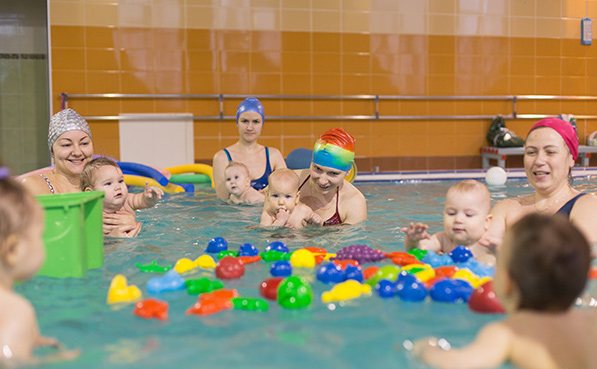
The center’s specialists promise to teach a child the basics of swimming movements in just a month, help him get rid of his fear of water and begin to dive into the water with ease.
The water is purified by ozonation and chlorination. The water temperature in the pool is maintained at 30-35 degrees.
Training takes place in the Harmony swimming pool near the Troparevo, Konkovo or Belyaevo metro stations at the address: st. Samora Machela, 6, building 4.
The cost of a one-time visit is 1100 rubles, when purchasing a subscription - 800 rubles.
BrightFamily Family Positive Lifestyle Center
When choosing a pool for babies under one year old in Moscow, you should familiarize yourself with the Brightlight early swimming program, which is known for its gentle approach to the baby and patented effective techniques. This system is practiced at the BrightFamily family center for positive lifestyle.
The center's instructors focus on establishing and strengthening a strong emotional bond between parent and child in the aquatic environment. This connection is achieved with the help of special techniques, mastery of which helps you learn to easily stay in the water.
Brightlight specialists, based on many years of international experience, claim that children who have mastered this technique are more developed physically, intellectually and emotionally and, accordingly, are more successful in life.
This system involves classes for children aged 1.5 months and older together with their parents. There is a specialized pool for them with a water temperature of 32 degrees.
The BrightFamily Center is located near the Polyanka or Tretyakovskaya metro stations at the address: Staromonetny lane. 18.
The cost of a one-time group lesson is 1,400 rubles, and an individual training session with an instructor is 2,500 rubles.
Splash Swimming School
Splash Swimming School provides swimming lessons for children from 3 years of age and for adults of any age. Experienced instructors conduct group and personal lessons, guaranteeing a special approach to each student, taking into account his physical and physiological characteristics.

The cost of an individual lesson in swimming lessons from 3 years of age is 1,300 rubles. A subscription for 8 group classes will cost 5,200 rubles.
Branches of the swimming school for children from 3 years old are located near the Botanical Garden metro station at the address: st. Wilhelm Pika, 4/12, near the VDNH metro station at the address: st. Kasatkina, 23 and a small swimming pool - next to the Otradnoe metro station on Kargopolskaya street 15, building 1.
What do you need for swimming lessons?
For classes in the swimming section, parents will be asked to prepare:
- swimming trunks for boys or swimsuit for girls;
- rubber cap for the pool;
- rubber slippers for walking from the locker room to the pool;
- goggles to protect eyes from water;
- soap, washcloth, towel (you must take a shower before and after the pool).
Some inventory differs slightly in different sections. When registering for the pool, the trainer will definitely tell you what swimming accessories you need to buy for your baby.
Children's aqua
The new children's aqua also offers swimming lessons for children in Moscow.
Teaching swimming to children over 3 years old in a pool without parents is especially popular because it is from this age that children are able to study in groups with a coach, hear his commands and perform exercises independently. The pool also offers individual lessons with an instructor.
Children's training includes a large number of playful elements, while older children practice in a more serious manner, learning different swimming styles and practicing breathing exercises.

“Octopussy” also practices infant swimming using the Brightlight method, which helps mother and baby experience complete unity with the aquatic environment and with each other, which is very important at such an early age.
The water temperature in the pool is 33 degrees. Water is disinfected by ultraviolet light with ozonation and moderate chlorination, which is considered one of the most modern cleaning methods.
Children's pool from 3 years old "Osminozhka" is suitable for residents of the Eastern Administrative District, as it is located next to the Shchelkovskaya metro station at the address: st. 16th Parkovaya, no. 51.
The cost of a subscription for 8 classes is 6,400 rubles (800 rubles per class). The same subscription, but with individual training, will cost 12,000 rubles (1,500 rubles per lesson).
What swimming styles can a child master?
The most suitable swimming style for a beginner swimmer is crawl. Swimming styles such as breaststroke and butterfly are difficult to perform and are not suitable for learning to swim. Crawl swimming consists of alternating wide strokes with the arms along the axis of the body and alternately raising and lowering the legs. You can swim the crawl either on your chest or on your back.

Crawl is the most suitable style for learning to swim.
It’s easier to start teaching your child the crawl with easier techniques:
- The leg movements are the same as when swimming front crawl. The starting position of the arms is extended forward. Straight arms simultaneously make a downward stroke, reach the level of the hips, bend at the elbows and return to the starting position with the hands forward under the chest. And also the arms can work in a different way: straight arms simultaneously reach the hips through the sides, then bend at the elbows and return to the starting position;
- The legs move in the same way as when swimming backstroke. The starting position of the arms is extended along the body. The arms are bent at the elbows along the body, extended behind the head so that the palms are turned outward, and return to the starting position through the sides.
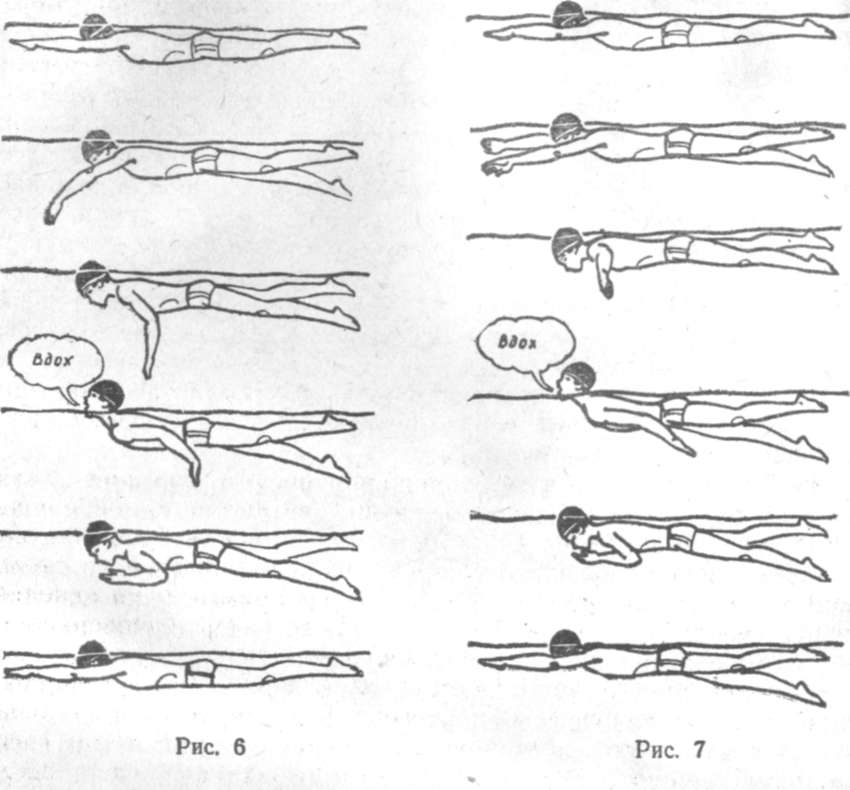
Lightweight front crawl swimming techniques involve simultaneously moving your arms
It is very important that the adult who will teach the child is good at one or another swimming style. After all, it is impossible to teach someone else what you cannot do yourself.
Sea water pool "Atlant"
If you have been looking for a pool in Moscow since the age of 4, pay attention to aqua with sea water. Swimming lessons are offered here for children from 4 years old up to adulthood.
The pool employs five experienced specialists who work with children of different age categories (from 4 to 18 years old).
The pool is proud of its unique sea water, which has a positive effect on the circulatory system and fights many diseases.
The water temperature in the pool is 28 degrees. Water undergoes regular purification based on electrolysis.
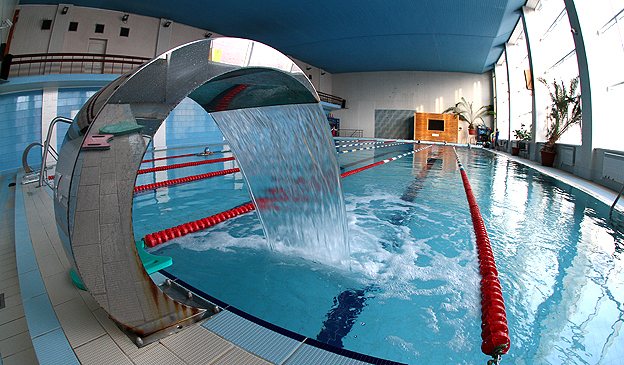
The cost of a group lesson in the pool for children from 4 years old is 850 rubles.
An individual lesson for a child will cost 1,300 rubles.
The Atlant pool is located next to the Volgogradsky Prospekt metro station at the address: st. Talalikhina, 28.
Registration for classes for young children and expectant mothers under the “Children of Love” program has also opened at the Atlant swimming pool. Children's groups in the pool are divided by age:
- from 1.5 months to a year,
- from 1 to 2 years,
- from 2 to 3 years,
- from 3 to 6 years.
Experienced instructors offer children a set of exercises, including adaptation to water and the basics of swimming, including underwater swimming. There are hardening elements, after which you can warm up properly in the Finnish sauna.
The division into age groups is not accidental. It involves the use of different teaching methods depending on the age and abilities of the child. Thus, experts are sure that teaching swimming to children from 3 years of age has significant differences from infant swimming.
The cost of a one-time group lesson under the “Children of Love” program is 1,400 rubles (1,200 rubles when purchasing a subscription). The price for an individual lesson (adult plus child) is 2500 rubles and 2000 rubles for a subscription.
Swimming in kindergarten.
Swimming is one of the most important links in raising a child - it promotes comprehensive physical development, stimulates the activity of the nervous, cardiovascular and respiratory systems, and significantly expands the capabilities of the musculoskeletal system.
It is one of the best means of hardening and forming correct posture. Swimming is a powerful emotional and positive factor that allows you to solve important problems. Helps correct poor posture, prevents flat feet, helps relieve muscle tone, develops coordination, rhythmic movement, and increases the body's motor capabilities. Systematic exercises in the pool improve the functioning of the circulatory and respiratory organs. Has a powerful hardening effect.
The main goal of the classes is to teach preschool children to swim; hardening and strengthening of the child’s body; teaching each child to be aware of physical exercise; creating the basis for versatile physical development.
During the classes, tasks on forming are solved:
- swimming skills;
- taking care of your health;
- personal hygiene skills;
- the ability to control your body in an unusual environment.
What effect does swimming have on a child’s body?
Swimming improves the functionality of the nervous system, its autonomic functions, and increases the mobility of nervous processes. It is especially useful for those children who are overly excited. The water temperature and monotonous cyclic movements have a calming effect on the nervous system, make the child calmer, and ensure sound sleep.
During immersion and swimming, unique conditions are created for the functioning of the heart and the entire cardiovascular system. During swimming, regular bathing, or just staying in the water, changes occur in the composition of the blood.
Swimming hardens the human body, increases its resistance to temperature fluctuations and immunity to colds. Water has both mechanical and thermal effects on the skin. It washes away dirt, sweat, sebum, and the top layer of epithelium from the skin, i.e. cleanses the skin, improves skin respiration and strengthens the skin itself.
Swimming affects a child's growth. Swimming is an indispensable tool for creating a “muscle corset.” Swimming is one of the means of treating the consequences of limb fractures and spinal cord diseases associated with motor dysfunction. Swimming helps reduce excess fat deposits. At the same time, in very thin children, these activities help to increase subcutaneous fat, which, together with an increase in muscle strength and volume, improves posture.
Organization of swimming lessons in kindergarten.
Swimming lessons should be held no earlier than 40-50 minutes after a meal and no later than 1.5 - 2 hours before bedtime. In a kindergarten, the most acceptable time for swimming lessons is considered to be: before lunch - from 9:30 a.m. to 12:00 p.m.;
Swimming training takes place in the form of subgroup lessons. For activities in the pool, children are divided into two subgroups. Depending on the age, the number of children in subgroups will vary.
Swimming training at the preschool educational institution is conducted for each group 2 times a week.
- the younger group studies for 15-20 minutes;
- middle group – 20 -25 minutes;
- senior group – 25 minutes-30 minutes.
- preparatory group – 30 -35 minutes.
Classes in the pool in our kindergarten are held starting from the second youngest group (3 years). The first lesson takes the form of a tour of the pool, during which the instructor introduces the rules of behavior in the pool (shows the children where and how to undress and change clothes, put on a bathing cap, how to wash in the shower, and walk along the walkway).
The training consists of three stages:
- getting used to water;
- water development;
- mastering swimming movements.
In our kindergarten, swimming is given great importance. This work is carried out by a swimming instructor.
About the importance of swimming for a child’s body.
Swimming in the pool for children of early preschool age for the purpose of improving their health and teaching them practical skills began to be introduced in our country and abroad in the 70s of the last century (although in fact the roots of this method go back to ancient times). It is known how often accidents on the water are recorded, occurring due to the fact that the victims, including children, do not know how to swim. If children from an early age were taught to float freely on the water and swim at least a short distance, and also developed a culture of behavior on the water, then many would be protected from possible misfortune.
At the same time, the main goal of teaching preschoolers to swim is to promote their health and hardening, and ensure comprehensive physical training. Bathing, swimming, games and water activities have a beneficial effect on all body systems.
GUIDELINES.
It is recommended to start learning to swim with preparatory exercises on land. This allows children to master movements in the water faster and more correctly. The fragility and immaturity of the child’s body require careful consideration of the abilities, inclinations, and most importantly, the capabilities of each child. Only with strict consideration of gender, age, level of physical development, health status, susceptibility to colds, water habits and changes in temperature conditions, individual reactions to physical activity can the most effective methods of learning to swim be found. The methodology for teaching swimming to preschoolers is based on the basic didactic requirements of pedagogy and is educational and developmental in nature.
Objectives of swimming training by age group.
Second youngest.
- Teach children not to be afraid to enter the water, teach them to splash in it.
- Teach how to move in the water along the bottom of the pool in different ways at different depths.
- Learn to dive into water and open your eyes in it. Learn to hold your breath underwater, dive. Learn to exhale into water while immersing yourself up to your nose. and with immersion of the face and head.
- Learn to lie on the water (on your chest), holding the handrail with your hands, holding the teacher’s hands with support. Learn to lie down on your own.
- Learn to perform chest slides with auxiliary equipment.
When teaching swimming to young children, much attention is paid to the initial stage of developing the correct skills.
Learning each swimming exercise (movement) requires a certain readiness from the child, so it comes down to play.
Middle group
- Learn to move independently in the water in different directions, in different ways.
- Learn to dive into water, hold your breath, dive under a toy. Learn to dive and collect objects from the bottom of the pool.
- Learn to exhale into the water while immersing your face and head.
- Learn to lie on the water with the support of a teacher and independently.
- Learn to glide on the surface of the water on your chest and back with the help of an adult and with auxiliary equipment.
- Learn to perform movements with your legs and arms on land and in water as when swimming crawl.
- Develop physical qualities: strength, endurance, speed.
In children of middle preschool age, the swimming skills and abilities acquired in classes in the younger group are consolidated. Much attention at this age is paid to instilling organization and discipline in children. The training uses a variety of exercises for special training and games to master movements in water. Games for acquiring diving skills.
Senior group.
- Learn to immerse yourself in water for longer periods of time.
- Learn to exhale into the water (alternate inhaling over the water with exhaling into the water).
- Learn to slide. On your chest on your back, pushing off with your feet from the bottom and walls of the pool.
- Learn to slide in combination with exhaling into the water.
- Teach coordination movements with your feet in the water, leaning on your hands, lying on your back and chest.
- Teach leg movements in sliding on the chest, on the back (like a crawl) with and without a movable support (boards).
- Training in coordination abilities in water. teach arm movements in swimming on the front and back.
Classes in the senior group include: exercises and games for the development of hands, breathing exercises, exercises for special training, games for mastering sliding skills, relay race games.
Preparatory group.
- Learn to lie in water on your back and chest for a long time.
- Learn to slide in water on your chest, on your back in combination with movements of your legs and arms.
- Learn to dive into the water.
- Teaching easier swimming methods with footwork and supporting stroke movements of the arms (on the back, on the chest).
- Development and improvement of coordination abilities in water, learning combinations of movements with arms and legs while holding the breath and exhaling into the water.
Games and entertainment on the water
Water games help solve a number of pedagogical problems. The game develops the child’s strong-willed qualities, feelings of camaraderie and collectivism. By developing and strengthening the body, it consolidates and improves swimming skills. By increasing the emotionality of the activity, the game is used as relaxation and entertainment. However, some negative points should also be noted. Carried away by the process of the game and trying to become winners, children stop monitoring the accuracy of the elements of swimming movements and perform them incorrectly. Repeated repetition of incorrect (from the point of view of swimming technique) movements can lead to them becoming habitual. Therefore, games used to reinforce any skill should be designed so that the correct execution of the movement is the main condition.
Simple plotless games are played mainly with beginners, so that they feel more confident in the water and learn how to move. When this goal is achieved, you can move on to a complex game with a plot and competitive elements.
The explanation of the rules of the game should be brief and figurative. If the movements are complex, then the story is accompanied by a demonstration. First you need to play the game on the shore, and only then in the water. You cannot remove individual participants from the game before it ends.
Swimming is a family affair
Swimming is an effective strengthening and healing tool for all family members, from the youngest to the oldest.
In water, a person finds peace and balance, stress and anxiety are absent, the number of family quarrels and scandals is significantly reduced.
By exercising in the water with children, you not only help them grow healthy, but also unobtrusively educate them, because... in the process of training such qualities as discipline, determination, and willpower are formed. But it is precisely these that children sometimes lack so much.
You will get to know your child better, learn to understand each other, and become more friendly.
So, do you want to be a healthy and friendly family?
Swim and teach your children to swim!
State Budgetary Institution "Moscow Olympic Aquatics Center"
Parents of future champions should pay attention to the Moscow Olympic Aquatics Center, where there is a swimming section for children from 3 years old.
Classes are held in groups of 6-7 people and last 30-45 minutes. According to instructors and methodologists, this is the most effective system for teaching swimming to children from 3 years old in Moscow.
The water temperature in the training pools is 32 degrees.
A group of children aged 7 to 14 years study for 45 minutes at a water temperature of 27-28 degrees.
Classes for children are held at the Swimming House near the Izmailovo, Semenovskaya or Partizanskaya metro stations at the address: st. Ibragimova, 32.
The cost of a one-time visit is from 350 rubles, when purchasing a subscription – from 310 rubles.
At what age should you start teaching your child to swim?
For the little ones there is infant swimming. Such activities will bring a healing effect and teach kids not to be afraid of water.
But most swimming sections accept those from 3-4 years old. According to teachers and psychologists, children who have reached this age are most ready to learn to swim and interact with water. At this age, children already have sufficiently developed thinking and coordination of movements. Very young children simply will not be able to understand or follow the basic rules of swimming.
In order to give beginners due attention and ensure the necessary safety in the water, preschoolers are most often taught to swim individually or in small groups (up to 5 people).
At the age of 3-6 years, children learn the basics of swimming, learn the properties of the aquatic environment, and master ways to hold the body in horizontal and vertical positions. Upon reaching 6 years of age, children learn to lie down and float on their backs.
Their parents must be present at preschoolers' lessons in the pool.
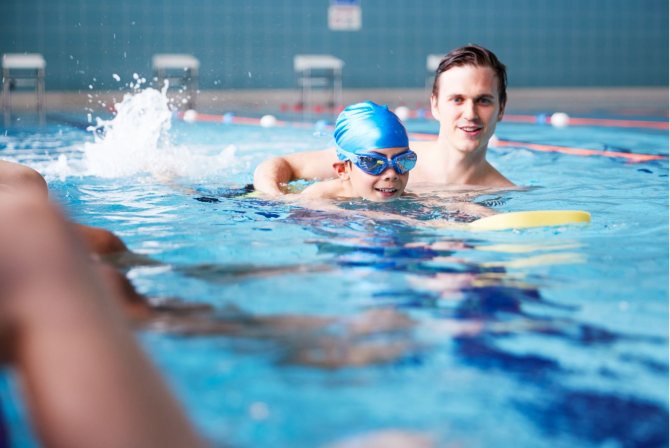
From 6-7 years old, a child is ready to master swimming styles - breaststroke, crawl. If at this age a preschooler is just starting to exercise, the coach will first teach him to hold his body on the water, relax, and correctly coordinate the movements of his arms and legs.
It is possible to teach children to swim professionally starting from the age of 7. At this age, children are already showing effective results and have the necessary abilities and physical indicators.
Family wellness
The family recreation center conducts water activities for different age groups. And the presence of several branches of the center will definitely help answer the question: where to send your child to the pool.
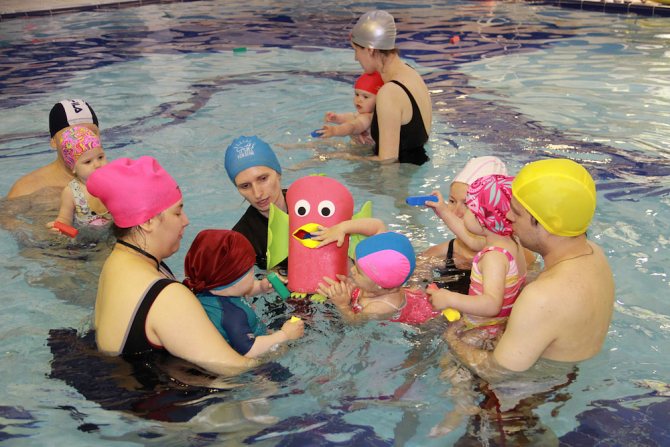
“Second Birth” conducts:
- infant swimming for babies with mothers or fathers for the age group from 1.5 months to 1 year,
- classes in the children's pool from 1 year to 2 years - they are also held together with parents,
- classes in the pool for children from 2 years old - in Moscow and the Moscow region,
- swimming section for children from 4 years old in several branches of the center,
- training in the pool for children from 6 years old in Moscow and the Moscow region.
According to the rules of the pool, the section for children of the third and fourth age groups works in such a way that parents can be in the water with the child or wait for him on land at their discretion.
The cost of a one-time visit to the pool is from 750 rubles, when purchasing a subscription - from 600 rubles. The final price depends on the specific branch.
Branches of the health center operate in several districts of Moscow at the following addresses: st. Larch alley, 12 B (Petrovsko-Razumovskaya metro station), st. Kosinskaya, 12B (metro station Vykhino), st. Bolshaya Filevskaya, 18 (metro station Bagrationovskaya), st. Rabochaya, 53 (metro station Ploshchad Ilyicha) and in the Moscow region (Khimki, Dolgoprudny).
Medical examination before swimming
Before sending your child to the section, you will definitely need to consult with a pediatrician and obtain a certificate of admission to the pool.
Medical contraindications may include:
- skin diseases that pose a danger to other children (eczema, scabies, fungus, dermatitis, furunculosis);
- presence of signs of an infectious disease (fever, runny nose, cough, sore throat);
- cardiovascular diseases (for example, heart disease);
- lung diseases (tuberculosis, bronchitis, asthma, pneumonia);
- chronic and acute diseases (kidney disease, epilepsy, seizure syndrome, syphilis, oncology and others).
Sports and fitness complex "Chaika"
When choosing a section in the pool for children over 5 years old, pay attention to the Chaika sports and fitness complex.
"Chaika" is famous for one of the best open-air swimming pools in Moscow. Children up to 18 years of age are taught swimming here. Depending on the age, the child falls into the group of “babies”, “frogs”, “fish” or “dolphins”.
The pool also provides the opportunity to take personal training with an instructor.

The water temperature in the pool is maintained at 28 degrees throughout the year. Highly effective modern methods of water purification are used.
The cost of a subscription for group swimming in Moscow from 3 years old is 3,300 rubles (6 lessons). Each individual lesson for a child with a teacher will cost 1,500 rubles.
The Chaika pool is located near the Park Kultury metro station at the address: Turchaninov lane, 3, building 1.
What to do if your child refuses to go swimming
The benefits of swimming for children are undeniable, but often enough when faced with difficulties during training, children begin to refuse to attend the section. In this situation, parents need to assess the situation according to several criteria:
Ask your child about the reasons for not wanting to attend the selected section.
Depending on the child’s answer, there are several options:
- I don't like the coach and his teaching style. In such a situation, you need to clarify what exactly the child does not like about the coach. Perhaps the section leader demands too much from the child or does not explain it clearly enough. In this situation, you can go up and talk directly with the coach about his view of the current situation, if after that the situation does not change, you can find another specialist.
- Difficulty performing the proposed load. Talk to the trainer, ask that the training program be revised for the time being for your baby.
- Misunderstanding with the guys in the group. In children's groups, sometimes there are clashes and ridicule; if your baby refuses to go because of difficulties in communicating with other children, talk to the coach so that he can use pedagogical technologies and talk with the parents of other children.
In any case, before refusing to visit the pool, you need to talk with the coach, find out his opinion about your child’s abilities and capabilities, and hear his professional opinion about the current situation. Children, especially younger schoolchildren, cannot always clearly explain the reason for their reluctance to attend the section. If you do not find the reason for this reluctance, then there is a possibility that the same problems will appear in another circle or section. The first step to regaining the desire to take extra classes is to find the reason for the rejection.
Offer to try another sport
Swimming is a good form of exercise, but not all children enjoy going to the pool. Each baby is individual, and perhaps another sport will be more desirable for your baby. This option is suitable for you if the child, being on good terms with the coach and children, performs all the proposed loads easily, does not feel the desire to go to training, and enthusiastically talks about other activities.
"Branch of MPO named after I. Rumyantsev"
If you want to enroll your child in the pool as an adult, a worthy option is the “Branch of the I. Rumyantsev MPO.” The sports complex has been operating for more than forty years, and is constantly updated and meets all modern requirements. Experienced trainers teach swimming here to children from 7 years old and adults of all ages. This sports complex with a swimming pool is ideal for activities with children 10 years and older. In the children's and adult pools of the complex, the water temperature is maintained at 26-27 degrees.
The sports complex is located near the Savelovskaya metro station at the address: st. Pistsovaya, 12.

The cost of an individual lesson with an instructor is 1,650 rubles; if you purchase a subscription, it is more profitable.
We hope our selection will help you find a good children's pool in your area and raise, if not a world champion swimmer, then certainly a healthy and happy child.
Previously, we compiled a rating of the best children's quests in Moscow and told where to celebrate a child's birthday.
Cover: magichild.ru
- share with your friends!
Group or individual?
It is important to understand that all children are different and each is unique in their own way.
Some guys need rivals and healthy competition to move forward. For others, on the contrary, it is easier to achieve success solo. It all depends on the athlete’s temperament, upbringing and personal characteristics. We recommend trying both interaction formats if you find it difficult to choose. It is important to select a coach with whom your child will feel calm and relaxed. Only in this state will he be able to trust a stranger and join the learning process. Admission of students to swimming sections for children is by appointment only. To clarify the data, contact the employees of the water complex by phone +7, we will select the optimal time and offer an effective program. All the necessary information is also posted on the official website of the complex.
